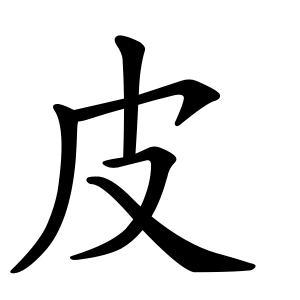皮
- skin;
- hide;
It specifically refers to the "skin of an animal" or "skin" in general.
Etymology
According to the Shuowen Jiezi (説文解字 shuōwén jiězì), the character 皮 is explained as a phono-semantic compound combining the semantic part 又 (hand) and a simplified form of 為 as the phonetic component.
However, based on the shape of ancient scripts, it is now believed that 皮 is not related to 為. Instead, it is considered a compound ideogram composed of the hand radical 又 and a part derived from removing one half of the character 革 (meaning "leather" or "hide"), representing animal skin.
Usage in Korean
When used as a radical, it conveys meanings related to skin or leather.
Words that derived from 皮
皮
가죽
피
gajuk
pi
Kangxi radical:107
Strokes:5
Unicode:U+76AE
Cangjie input:
- 木竹水 (DHE)
Composition:
- ⿻⿱ 丨 又 ⿰ 丿 乛
